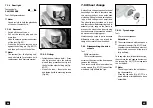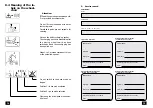
71
70
8.2 Fuses
Under the seat
Drive-electronics (Fig. 78/
➀
): .............................................. 1 x 70 A
Battery bridge on the battery cover (Fig. 78/
➀
): .................. 1 x 70 A
Fuse holder for 4 fuses, in the seat module (Fig. 78/
➁
)
Lighting: ................................................................................ 2 x 4 A
Lighting and control system: ................................................ 1 x 15 A
Electrical add-on devices: .................................................... 1 x 7,5 A
Lighting
Headlight bulb: .........................................filament bulb 24V/3W E10
Front indicator bulb: ........................... spherical bulb 24V/10W BA15s
Rear indicator: .................................... spherical bulb 24V/21W BA15s
Rear light: .............................................. Festoon bulb 24V/C5W S8,5
8. Technical data
8.1 Kilometric per-
formance
The kilometric performance (driving
range) is extremely dependent on the
following factors:
– battery condition,
– weight of the user
– driving speed
– driving style
– road surface condition
– driving conditions
– ambient temperature.
– Tyre
– Air pressure of tyres
The standard data which we have spec-
ified are realistic under the following
conditions:
– ambient temperature of 27°C.
– 100% nominal battery capacity in
accordance with DIN standard
– new batteries with more than
5 charging cycles,
– straight-ahead motion with fully au-
tomatic drive electronics (maximum
speed)
– nominal load of 75 kg
– smooth acceleration
– level road surface.
The kilometric performance is greatly
reduced by:
– frequent uphill travel,
– low battery charging status
– low ambient temperature,
(e.g. in winter),
– frequent starting and stopping
(e.g. in town traffic),
– old, sulphated batteries
– unavoidable frequent steering ma-
noeuvres
– reduced speed (especially walking
speed).
In practical use, the kilometric perform-
ance under 'normal conditions' is then
reduced to approx. 80% – 40% of the
nominal value.
8.1.1 Hill-climbing ability
We have specified that the vehicle may
be driven on gradients of up to 15% but
point out that the system-related hill-
climbing ability is much higher because
this ability must be made available for
the safe crossing of obstacles.
– nominal load of 75 kg.
– normal road surface.
Rising/falling gradients of more than
15% must be driven without driver for
safety reasons (e.g. on ramps!





































